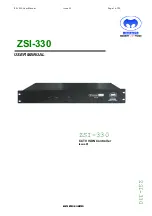
DM5210 analog input module 5-4 RTD Embedded Technologies, Inc.
A/D Calibration
Two procedures are used to calibrate the A/D converter for all input voltage ranges. The first procedure cali-
brates the converter for the unipolar range (0 to +10 volts), and the second procedure calibrates the bipolar ranges
(±5, ±10 volts). Table 5-1 shows the ideal input voltage for each bit weight for all three input ranges.
Unipolar Calibration
Two adjustments are made to calibrate the A/D converter for the unipolar range of 0 to +10 volts. One is the
offset adjustment, and the other is the full scale, or gain, adjustment. Trimpot TR4 is used to make the offset adjust-
ment, and trimpot TR1 is used for gain adjustment. This calibration procedure is performed with the module set up
for a 0 to +10 volt input range. Before making these adjustments, make sure that the jumpers on P5 and P6 are set for
this range.
Use analog input channel 1 (gain = 1) while calibrating the module. Connect your precision voltage source to
channel 1. Set the voltage source to +1.22070 millivolts, start a conversion, and read the resulting data. Adjust
trimpot TR4 until it flickers between the values listed in the table at the top of the next page. Next, set the voltage to
+9.49829 volts, and repeat the procedure, this time adjusting TR1 until the data flickers between the values in the
table.
Table 5-1: A/D Converter Bit Weights for All Input Ranges
A/D Bit Weight
Ideal Input Voltage (millivolts)
-5 to +5 Volts
-10 to +10 Volts
0 to +10 Volts
4095 (full-scale)
+4997.56
+9995.12
+9997.56
2048
0000.00
0000.00
+5000.00
1024
-2500.00
-5000.00
+2500.00
512
-3750.00
-7500.00
+1250.00
256
-4375.00
-8750.00
+625.00
128
-4687.50
-9375.00
+312.50
64
-4843.75
-9687.50
+156.25
32
-4921.88
-9843.75
+78.13
16
-4960.94
-9921.88
+39.06
8
-4980.47
-9960.94
+19.53
4
-4990.23
-9980.47
+9.77
2
-4995.12
-9990.23
+4.88
1
-4997.56
-9995.12
+2.44
0
-5000.00
-10000.00
0.00
Artisan Technology Group - Quality Instrumentation ... Guaranteed | (888) 88-SOURCE | www.artisantg.com
















































